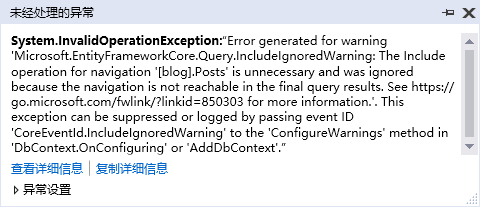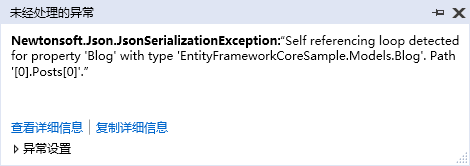Entity Framework Core 允许使用导航属性来加载相关实体。
加载关联数据三种方式
预先加载:表示从数据库中加载关联数据,作为初始查询的一部分。显式加载:稍后手动控制时,从数据库中显式加载导航数据。
延迟加载:当访问导航属性时,才从数据库中加载导航属性数据。
IQueryable 未使用时不会执行查询行为,生成一个表达式树,需要时执行。
默认情况下导航属性不加载任何数据
var blog = _context.Blogs.Find(1);
预先加载
可以使用 Include 方法来指定要包含在查询结果中的关联数据。
var blogs = _context.Blogs.Include(blog => blog.Posts).ToList();

多个导航属性预先加载
var blogs = _context.Blogs.Include(blog => blog.Posts) .Include(blog => blog.Owner).ToList();
多层级导航属性加载
使用 ThenInclude 方法可以依循关系包含多个层级的关联数据。
var blogs = _context.Blogs.Include(blog => blog.Posts)
.ThenInclude(post => post.Author)
.ThenInclude(author => author.Photo)
.ToList();
可通过链式调用 ThenInclude 方法,进一步包含更深级别的关联数据。
var blogs = context.Blogs
.Include(blog => blog.Posts)
.ThenInclude(post => post.Author)
.ThenInclude(author => author.Photo)
.ToList();
可以将来自多个级别和多个根的关联数据合并到同一查询中。
var blogs = context.Blogs
.Include(blog => blog.Posts)
.ThenInclude(post => post.Author)
.ThenInclude(author => author.Photo)
.Include(blog => blog.Owner)
.ThenInclude(owner => owner.Photo)
.ToList();
这些 Incloude 在大多数情况下,会在生成 SQL 的 JOIN 联接查询。
派生类型上的导航属性加载
可以使用 Include 和 ThenInclude 包括来自仅在派生类型上定义的导航的相关数据。
使用强制转换方式:
context.Peoples.Include(person => ((Student)person).School).ToList()
使用 as 运算符方式:
context.Peoples.Include(person => (person as Student).School).ToList()
使用采用类型 string 的参数的 Include 的重载:
context.Peoples.Include("School").ToList()
忽略导航属性加载
如果更改查询,从而使其不再返回查询以之为开头的实体类型的实例,则会忽略 include 运算符。
以下示例中,include 运算符基于 Blog,但 Select 运算符将查询改变为返回匿名类型。 在这种情况下, include 运算符没有任何效果。
var blogs = _context.Blogs
.Include(blog => blog.Posts)
.Select(b => new
{
b.Name,
Posts = b.Posts.ToList()
});
默认情况下,当忽略 include 运算符时,EF Core 将记录警告。
dbContextOptionsBuilder..ConfigureWarnings(warnings => warnings.Throw(CoreEventId.IncludeIgnoredWarning)))

显式加载
var blog = _context.Blogs.Single(b => b.BlogId == 1); _context.Entry(blog).Collection(b => b.Posts).Load(); _context.Entry(blog).Reference(b => b.Owner).Load();
导航属性加载时,可生成远程 SQL 查询条件。
var postCount = _context.Entry(blog).Collection(b => b.Posts).Query().Count();


var goodPosts = _context.Entry(blog).Collection(b => b.Posts).Query().Where(p => p.Rating > 3).ToList();

延迟加载
使用代理的最简单延迟加载
使用延迟加载的最简单方式是通过安装 Microsoft.EntityFrameworkCore.Proxies 包,并通过调用UseLazyLoadingProxies 来启用该包。
Install-Package Microsoft.EntityFrameworkCore.Proxies optionsBuilder.UseLazyLoadingProxies().UseSqlServer(myConnectionString);
EF Core 将为可重写的任何导航属性(必须是 virtual 修饰符,且可被继承)的导航属性上启用延迟加载。
public class Blog
{
public virtual ICollection<Post> Posts { get; set; }
}
不使用代理的延迟加载
不使用代理进行延迟加载的工作方式是将 ILazyLoader 通过构造函数注入到实体中。
public class Blog
{
private ICollection<Post> _posts;
public Blog()
{
}
private Blog(ILazyLoader lazyLoader)
{
LazyLoader = lazyLoader;
}
private ILazyLoader LazyLoader { get; set; }
public int Id { get; set; }
public string Name { get; set; }
public ICollection<Post> Posts
{
get => LazyLoader.Load(this, ref _posts);
set => _posts = value;
}
}
public class Post
{
private Blog _blog;
public Post()
{
}
private Post(ILazyLoader lazyLoader)
{
LazyLoader = lazyLoader;
}
private ILazyLoader LazyLoader { get; set; }
public int Id { get; set; }
public string Title { get; set; }
public string Content { get; set; }
public Blog Blog
{
get => LazyLoader.Load(this, ref _blog);
set => _blog = value;
}
}
这样,将不要求实体类型为可继承的类型,也不要求导航属性必须是虚拟的。
ILazyLoader 接口依赖于 Microsoft.EntityFrameworkCore.Abstractions 包。
Install-Package Microsoft.EntityFrameworkCore.Abstractions
不过,可以将 ILazyLoader.Load 方法以委托的形式注入,这样可以不依赖于任何包。
public class Blog
{
private ICollection<Post> _posts;
public Blog()
{
}
private Blog(Action<object, string> lazyLoader)
{
LazyLoader = lazyLoader;
}
private Action<object, string> LazyLoader { get; set; }
public int Id { get; set; }
public string Name { get; set; }
public ICollection<Post> Posts
{
get => LazyLoader.Load(this, ref _posts);
set => _posts = value;
}
}
public class Post
{
private Blog _blog;
public Post()
{
}
private Post(Action<object, string> lazyLoader)
{
LazyLoader = lazyLoader;
}
private Action<object, string> LazyLoader { get; set; }
public int Id { get; set; }
public string Title { get; set; }
public string Content { get; set; }
public Blog Blog
{
get => LazyLoader.Load(this, ref _blog);
set => _blog = value;
}
}
public static class PocoLoadingExtensions
{
public static TRelated Load<TRelated>(
this Action<object, string> loader,
object entity,
ref TRelated navigationField,
[CallerMemberName] string navigationName = null)
where TRelated : class
{
loader?.Invoke(entity, navigationName);
return navigationField;
}
}
延迟加载委托的构造函数参数必须名为“lazyLoader”。 未来的一个版本中的配置将计划采用另一个名称。
关联数据和序列化
由于 EF Core 具有导航属性和反向导航属性,因此在对象图中可能会产生循环引用。某些序列化框架不允许使用循环引用。
Install-Package Newtonsoft.Json
var blogs = _context.Blogs.Include(blog => blog.Posts).ToList(); string jsonString = JsonConvert.SerializeObject(blogs);

可设置 JSON.NET 行为,忽略并防止循环引用。
JsonSerializerSettings settings = new JsonSerializerSettings(); settings.ReferenceLoopHandling = ReferenceLoopHandling.Ignore; string jsonString = JsonConvert.SerializeObject(blogs, settings);
另一种方法是使用 [JsonIgnore] 特性修饰其中一个导航属性。
[JsonIgnore]
public ICollection<Post> Posts { get; set; }
ASP.NET CORE 中可通过扩展方式配置 MVC 默认自带的 JSON 框架设置。
services.AddMvc() .AddJsonOptions(options => options.SerializerSettings.ReferenceLoopHandling = ReferenceLoopHandling.Ignore);